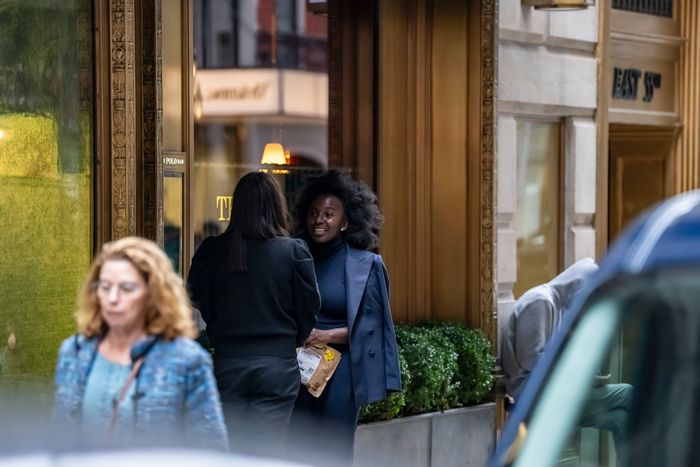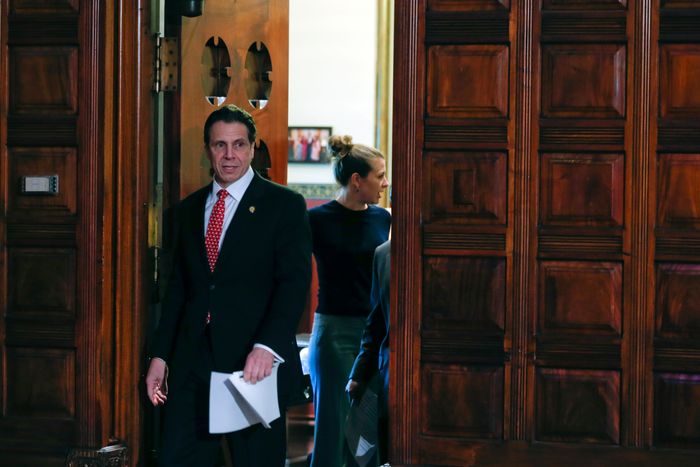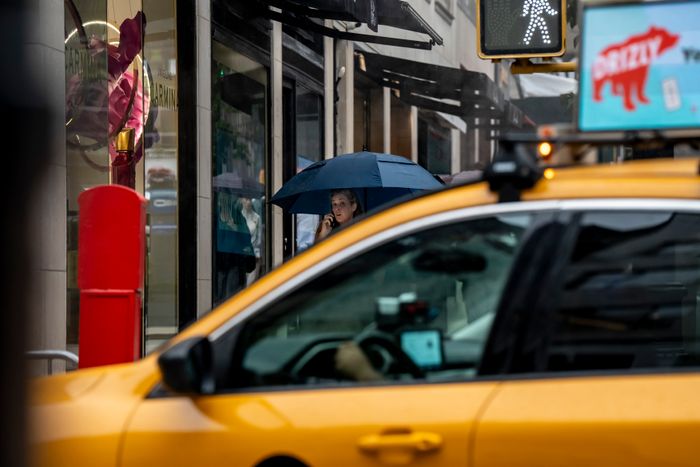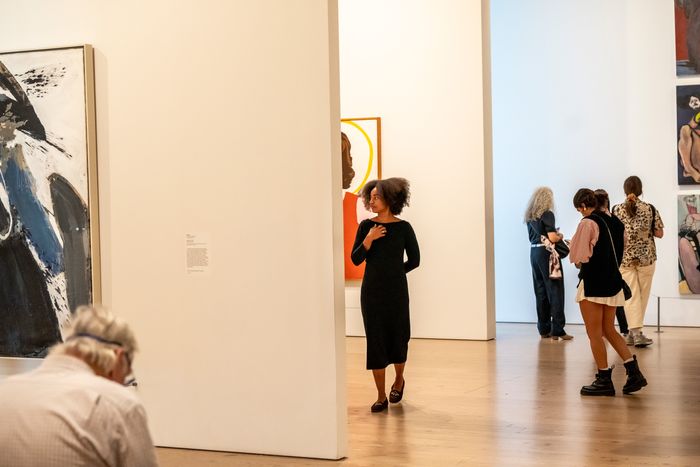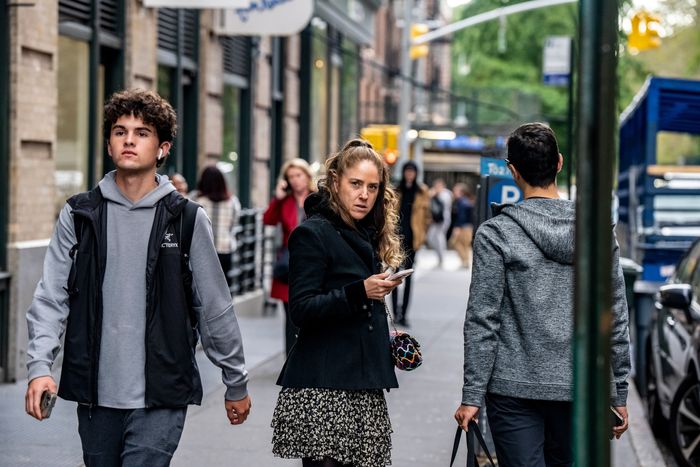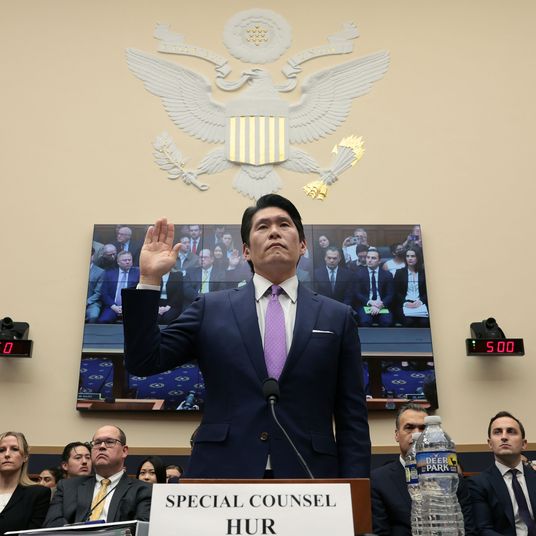For many years in its early history, this magazine took it upon itself to identify New York’s most powerful inhabitants, delineate their influence, and in doing so expose how the city actually operates. Earlier this year, when we set out to chronicle power post-COVID, we came to an unexpected conclusion. New York’s major power brokers — the moguls and the billionaires, the sort of people who bend the city to their will — are, as a group, remarkably staid and listless. Across government and media, Wall Street and the arts, the big machers are more likely than ever to shirk the spotlight, enjoy just minding the shop, or, in a lot of cases, simply be absent. Power vacuums abound.
Cover Story
At City Hall, a shallow mayor presides over a distinctly unambitious administration. On Broadway and in film, no producer exerts the creative control that Scott Rudin or Harvey Weinstein wielded and abused. The Times is now run by a caretaker editor, and in literature every publisher shrinks before the disaggregated forces of #BookTok. Even in finance, the New York industry that reigns above all others and where there is an undisputed captain in the old leader-of-men mold — well, his power is in doubt, too. “People in Washington care what Jamie Dimon thinks,” says a close adviser to the billionaire class. “But I have never in my life heard anyone in New York City or state politics reference his name and opinion on anything — ever.”
In some cases, power evaporated after the pandemic: The mightiest CEOs ordered their employees to return to the office and half said “no.” Others are likely keeping a lower profile after Me Too ended the careers of so many of their peers. A host of cultural leaders apparently decided the power wasn’t worth the hassle anymore — within the world of the performing arts alone, there are open positions at the top of Lincoln Center Theater, BAM, the Roundabout, and Second Stage — and newly appointed heads of the city’s publishing houses and museums are far less swaggering than those they replaced. Then there are the institutions whose once-vigorous captains have settled, seemingly permanently, into the role of custodian (The New Yorker, 25 years; MoMA, 28 years; Vogue, 35 years; BlackRock, 35 years; Saturday Night Live, 48 years).
Yet the city is obviously in the midst of transforming itself — this is forever true, and even more acute in a time of office apocalypse, migrant surge, and politics in perma-crisis. Perhaps, we wondered, it might be an interesting moment to consider a different kind of power: inside power. Hidden power. Stealthy power, leveraged by people who are fearsomely regarded in their industry and virtually unknown to anyone else. Who runs New York when the people who run New York don’t appear very interested in running New York?
We endeavored to find the answer. We cast a wide net — or dozens of nets, really, assigning reporters to dig deeply into the substrata of city politics, restaurants, tech, fashion, the law, nightlife, and more. This process turned up hundreds of names, from capital allocators to dominatrices, many of them suggested by the old-guard titans we elected to ignore at the outset. From there — after numberless hours debating the precise meaning of power — we winnowed the list down to the most convincing 49 New Yorkers, focusing on their distinct abilities to get things done in their respective universes. Ranking them was out of the question because we set filters for surprise and sheer interestingness, seeking out oddballs and the sui generis. We ruled out everyone famous, nearly everybody whose title is CEO or who was elected to office, and definitely everyone who caught wind of the project and suggested themselves. We kept in those who use their power subtly and a few who begged to be kept off. (Isn’t it true that the most powerful among us don’t want anyone to know?)
We believe the resulting project, while unconventional, honors the spirit of New York’s original power lists, and we hope it provides a similar service: an X-ray of how the city actually operates right now. If part of the thrill of living in New York is sitting down at I Sodi and seeing a genuine big shot like Tish James or Larry Fink at the next table, it may be even more thrilling to consider every other table in the restaurant and realize you’re probably in the vicinity of far more fascinating players.
The Index
The people who actually run New York, listed alphabetically: Téa Abashidze | Margaret Anadu | Jon Baker | Eddie Bautista | Serena Boardman | Carlee Briglia | Eduardo Castell | Yiatin Chu | Joanne Crevoiserat | Jonathan Davis | Piergiorgio Del Moro | Melissa DeRosa | Graham Duncan | Lee Fixel | Mara Gay | Ligia Guallpa | Alia Hanna Habib | Rujeko Hockley | Jackson Howard | A.C. Hudgins | Mistress Iris | Randall Jackson | GeGa Japaridze | Nathalie Gerschel Kaplan | Gabriella Khalil | Zaid Kurdieh | Mike Lavoie | Kihyun Lee | Gregg Lemkau | Alex Levy | Ingrid Lewis-Martin | Michelle Morse | Nelly Moudime | Carlos Nazario | Jay Newman | Tim O’Brien | Ellie Rines | Carolyn Ryan | Julie Samuels | Stanley Schlein | Amanda Silverman | Steve Simon | Aixa Torres | Bob Wankel | Peter Ward | Keith Wright | Zhang Xin | Elizabeth Yeampierre | Marlene Zwirner
The Power To:
Enforce the Mayor’s Petty Grudges
Ingrid Lewis-Martin “is the Adams administration.”
Eric Adams and Ingrid Lewis-Martin are so close that she was the first person he thanked from the stage at his Election Night party. When he was sworn in on New Year’s Eve in Times Square, she was at his elbow. Now, as the mayor’s chief adviser and the so-called Lioness of City Hall — an appellation she has embraced — she roams freely, the lone aide without portfolio.
“I don’t think you can say she has her fingerprints all over the Adams administration,” says a rival political operative. “She is the Adams administration. It is Brooklyn clubhouse politics brought to the whole city. And every dispute is a personal fucking bloodbath.”
It can often seem as if there are two Adams administrations. The first is a collection of policy technocrats, generally acknowledged to be experts in their field, who would likely find a home in any administration — and indeed are veterans of the Bloomberg and de Blasio years. (This faction is led by First Deputy Mayor Sheena Wright and includes deputy mayors like Anne Williams-Isom and Maria Torres-Springer.) The second is composed of Adams loyalists whose expertise is what could charitably be described as “operationalizing” the mayor’s agenda. They’re knife fighters, and they relish their mandate to destroy the mayor’s enemies. Lewis-Martin is their alpha. “When they go low,” she once told an interviewer, “we dig for oil.”
And so while one segment of City Hall is overhauling zoning laws, rethinking trash, and planning more bike and bus lanes, the segment Lewis-Martin leads is speaking to the mayor’s base of moderate and right-leaning outer-borough homeowners. You can see her influence in moves such as calling on the federal government to close the southern border, backing challengers to state lawmakers who oppose the mayor’s policing initiatives, and giving jobs to people with a history of making anti-gay comments — all dog whistles to Adams’s conservative fans. The tension is most apparent in Lewis-Martin’s efforts to counter initiatives by Adams’s own Department of Transportation to keep cars off a pedestrianized street in Fort Greene and bring traffic-calming measures to the deadly McGuinness Boulevard in Greenpoint. She has boasted about not taking the subway in 40 years.
“Most of my colleagues are afraid of her,” says a councilmember. “They think of her as someone who can make a few phone calls and get people to show up for you if you need it or who can turn on the money spigot. You don’t want to get on her bad side. She will make your life miserable.”
On a recent night as New York was drenched in record-setting amounts of rain, Adams was at a $2,000-a-head reelection fundraiser in Inwood. As he was speaking, a protester interrupted, saying the mayor was pitting migrants against other unhoused New Yorkers and using Republican talking points. Before security could come to snatch the protester away, even before Adams could say much of anything in response, Lewis-Martin sidled up beside the mayor, towering over him, arms folded across her chest, glowering. — David Freedlander
The Power To:
Make (or Bury) a Career at the Times
Carolyn Ryan decides who gets a good beat, and who gets beaten down.
After the election of Donald Trump caught the New York Times by surprise, the paper reassigned its politics editor, Carolyn Ryan, to a new role: personnel czar. The move was technically a promotion — Ryan was now on the masthead — but to many it looked like she’d been sidelined. Turns out they got it all wrong. The Times, flush with new subscribers, embarked on a “Trump bump” hiring spree, and Ryan oversaw the recruitment of more than 400 people and a wave of promotions and reassignments. She also never entirely stopped editing; she’d “tear my columns up, and occasionally insult me, but always make them 30 percent shorter and 50 percent better,” says Ben Smith, whose media column Ryan looked after. By now, a huge portion of the staff views her as instrumental to their career. Last year, the new executive editor, Joe Kahn, made Ryan one of his two managing editors, giving her broad power to shape coverage from business to culture to — once again — politics.
Ryan can choose who gets plum postings and order up new beats. Juicy assignments await the writers she likes. (One of her favorites, Matt Flegenheimer, recently co-bylined a story about Rudy Giuliani’s drinking problem with Maggie Haberman — another early Ryan hire.) She knows how to dial up staffers’ insecurities to extract good work, but if she decides you’re a mediocrity, your career is pretty much on ice.
She remains inscrutable to much of the newsroom she helps run. The first openly gay woman on the masthead, Ryan has been responsible for hiring many of the more progressive young staff, and when this cohort gets upset over the way the paper is writing about, say, a trans youth clinic or the NYPD, Ryan will pop into a town hall to make everybody feel heard. She will rewrite headlines and ledes on sensitive stories, trying to keep them balanced, and has personally edited contrarians, such as Nellie Bowles and Michael Powell (who have both since left the paper). Because Ryan is apparently liked by the publisher, A. G. Sulzberger, and his cousin, Sam Dolnick — both of whom were cub reporters on the “Metro” desk when she ran it — she has unusual freedom to do as she pleases. —Shawn McCreesh
The Power To:
Sway City Politicians
They all read Mara Gay’s column.
At just about every Democratic campaign’s first organizational meeting, a staffer is assigned “Mara duty” — a full surveillance of the social-media feeds of the New York Times editorial board’s youngest member, Mara Gay. The paper’s pronouncements still matter quite a lot — mayoral candidate Kathryn Garcia jumped 15 points in the polls after the Times endorsed her — and Gay is emblematic of its shifting interests. For politicians desperate for the Times’ nod, her concerns are theirs.
Gay, whose remit includes city politics and government, brought the vantage of a Black millennial woman living in a rented apartment in Brooklyn to the board when she was hired in 2018. She helped housing affordability become the major issue in Albany this past session with Kathy Hochul unveiling the most expansive agenda of any governor in generations. In 2020, Gay was one of the leading voices advocating for the rezoning of Soho, and people involved in the battle say the board’s editorial helped push it over the finish line. “Politicians tend to not want to do things,” says one operative who pitches Gay regularly. “If you can convince Mara to write something, it gives them a bit of a nudge.” — David Freedlander
The Power To:
Propel Comedians Onto Netflix
Mike Lavoie and Carlee Briglia have charted a path from small theater to Broadway to beyond.
Roughly speaking, there are now two ways for a comic to break out of the New York scene. The first is to relentlessly post stand-up clips to social media until you build an audience big enough to justify a tour. The second is to workshop an ambitious solo show with a cohesive theme and theatrical-production value, hoping to turn it into a critical darling and, eventually, a highly paid special on Netflix. The latter track is more demanding and prestigious, and the producers who best know how to steer comedians through it are Mike Lavoie and Carlee Briglia.
“All people ever ask me about is ‘How can I get in touch with Mike and Carlee?’” says Alison Leiby, who worked with them on her hit 2022 production, Oh God, a Show About Abortion. “They’re so big and they’re so important and nobody outside comedy knows it,” says Alex Edelman, whose show Just for Us Lavoie and Briglia produced. Of the 18 shows Lavoie and Briglia have staged for extended runs, one has been turned into a major movie, three have advanced from Off Broadway to Broadway, and ten have gone on to become specials on Netflix and HBO.
Lavoie went to Georgetown with Mike Birbiglia, where they both performed on the improv team. In 2008, he worked as a producer on Birbiglia’s pioneering solo show Sleepwalk With Me, and a few years later began teaming up with Briglia, a fellow Georgetown graduate. (They’re aware that the similar names are confusing.) Their company, Mike & Carlee Productions, has backed hits by Neal Brennan (3 Mics), John Mulaney and Nick Kroll (Oh, Hello Live), Chris Gethard (Career Suicide), Jacqueline Novak (Get on Your Knees), and Kate Berlant (Kate), among others.
In their niche, Lavoie and Briglia have a reputation for low-key competence and profitability. They connect talent to investors, venues, and technicians; they also manage the comics’ neuroses, so they stay at ease while running shows that are orders of magnitude more complicated than performing a set at the Comedy Cellar. “They have a wry sense of humor,” says Colin Quinn, who has worked with the pair on at least five productions. “They’re so used to being around the comedy space, and they understand that talking to comedians is different from talking to actors.” — Hershal Pandya
The Power To:
Monopolize the Harbor
Tim O’Brien and his Hornblower armada have taken over the rivers.
A few years ago, the owner of Freedom Cruises, Pjeter Vulaj, received a letter informing him he had 24 hours to vacate his berth at Pier 36, just north of the Manhattan Bridge. Quickly, he came to the conclusion that Hornblower Group, another cruise operator, was after his spot and had enlisted the mayor’s office to get it. “They sicced the fire department on me, the health department on me; they went after my liquor license,” says Vulaj. “Hornblower has enough muscle that they can do whatever they like.” (Vulaj filed a lawsuit against the city, which he later dropped; Hornblower declined to comment.)
Hornblower is based in San Francisco, but Tim O’Brien, an M.B.A.-toting former sailing instructor, is the company’s VP in New York overseeing ferries and transportation, which makes him the most formidable figure on the city’s harbor. In 2007, the company won the rights to ferry millions of tourists to the Statue of Liberty. Hornblower began running dinner boats up and down the Hudson and by 2016 was the largest sightseeing operation on the water — and with the help of private equity, it gobbled up its closest competitor (RIP, Spirit Cruises). Hornblower’s fleet is now so substantial that the company recently opened its own shipyard maintenance facility in Bridgeport, Connecticut. “They have the biggest pocketbook, and the fear is they can come in and undercut everybody overnight,” says a wary independent charter-boat owner. “They’re too big to sink.”
Hornblower’s operation has grown to include NYC Ferry, which transported 6.1 million commuters last year and was part of Bill de Blasio’s vision for a comprehensive ferry system connecting all five boroughs. Whether or not it’s sustainable is another matter. An audit by Comptroller Brad Lander in 2022 reported that NYC Ferry operations had somehow lost track of $224 million and that taxpayers had subsidized a stunning $12.88 of every ride in 2021. Still, in a market where few other companies have the resources to compete, O’Brien was able to convince the city to re-up Hornblower’s contract at $405 million over the next five years. — James D. Walsh
The Power To:
Adjudicate Pickleball
For every decision about Manhattan Parks, Steve Simon is there.
When Katherine Hedden, a pickleball organizer, wanted courts painted onto precious Manhattan playground space, she knew she had to go through the Parks Department’s Steve Simon. Hedden pushed for two courts in Hell’s Kitchen; Simon said they could have one. The court got painted over an access panel; she called him again. During the negotiations, Hedden assumed that Simon was the Manhattan commissioner. Understandable mistake. He is technically the chief of staff to the commissioner — a man named Anthony Perez — but in reality he is the man standing between Manhattanites and the resolution of their grievances. “For all practical purposes,” says former councilmember Ben Kallos, “Steve Simon runs the Parks Department for Manhattan.”
Simon has held his role for nearly 20 years. He is a savant of Parks minutiae and a budget wizard, famous for apparating funds out of thin air. “He solves problems that no one else could solve,” says Councilwoman Gale Brewer. “Conflicts between park groups, how to address repairs in a dog run, what to do about a rat infestation.” State Senator Brad Hoylman-Sigal says Simon recently talked him into appropriating $1 million for a renovation of Little Engine Playground, a project that would ordinarily be financed by the city — or not at all. He can also slow down projects he isn’t keen on. Kallos goes into granular detail describing his yearslong crusade to persuade him to replace disused exercise equipment with a seniors area in John Jay Park. “He’s an intractable force. You, as a river, must bend around the rock,” says a chief of staff to another councilmember. “He’s a Seinfeld character.” Think Robert Moses crossed with Larry David. “If he’s explaining why he thinks something can’t be done, it’s not because he thinks you’re an idiot,” says another chief of staff. “It’s because you just don’t know, and he does.” — Simon van Zuylen-Wood
The Power To:
Murder Airbnb
As a hotel-union boss, Peter Ward set the platform’s local demise in motion. Next project: A casino in Queens.
Probably no one is more responsible for the coming ruination of Airbnb in New York than Peter Ward. Until 2020, Ward was the president of the Hotel and Gaming Trades Council, the union representing about 40,000 hospitality workers across New York and northern New Jersey. Over two decades, Ward transformed the organization into a political dynamo, winning large pay increases for bellhops and housekeepers while forging close relationships with every politician of note. Airbnb was a direct threat to HTC’s membership, and Ward catalyzed its downfall, pushing top hotel executives to unite against the marketplace and channel their donations to politicians who promised to implement tough rules limiting Airbnb’s operations. Ward even endorsed Bill de Blasio’s desultory run for president, surely knowing it would go a long way toward securing the mayor’s support in the fight.
Since retiring from HTC, he has run Ward Strategies, a consulting-and-lobbying firm with clients in commercial real estate, private equity, and health care. Ward’s most important customer may be the Malaysian conglomerate Genting, which operates Resorts World, the racino in southern Queens, which is relying on Ward as it vies against other gaming giants to land one of a limited number of downstate casino licenses. (Jay-Z and Steve Cohen are among the other bidders.) It helps that Ward has a certain sway over Joseph Addabbo Jr., the state senator whose district includes Resorts World. State rules require that for a casino to win a license, local politicians must support the project — no problem for Ward, who has won loyalty from virtually all of them through his years in the labor trenches. — Ross Barkan
The Power To:
Stop a Sunset Park Development
It was the work of environmental activists Elizabeth Yeampierre and Eddie Bautista.
The interests that have historically called the shots in Sunset Park’s Industry City are right there in the name. But recently, industry — as represented by the billion-dollar developer Jamestown — lost a seven-year effort to transform the waterfront district into an even bigger retail destination. Led by Elizabeth Yeampierre, an environmental-justice activist and the head of the Sunset Park community-advocacy organization Uprose, a local coalition managed to kill the project over concern that the rezoning would push out thousands of residents from the working-class community of color: Greenpoint or Williamsburg all over again. The coalition also wanted to preserve the waterfront in hopes of creating green jobs. “Elizabeth was the driving force,” says Representative Nydia Velázquez, whom Yeampierre recruited to the effort.
In 2021, Yeampierre helped notch another win for Sunset Park when the de Blasio administration announced the city-owned South Brooklyn Marine Terminal would be the assembly point for a gargantuan offshore wind project that should come online by 2026. On that one, Yeampierre teamed with her husband, Eddie Bautista, the executive director of the New York City Environmental Justice Alliance. Since they first began collaborating at an organizing workshop in 1987, the couple have pushed for cleaning up the neighborhoods that the city is most likely to pollute: poorer communities of color located near industrial zones. As the top legislative aide to Mayor Bloomberg, Bautista helped reform the way New York gets rid of the tens of thousands of pounds of trash it creates daily, switching from garbage trucks to barges and rail. Now, they’re working with state agencies to shut down “peaker” plants exposing outer-borough neighborhoods to excess emissions. — Matt Stieb
The Power To:
Keep Control of the Bronx
The game of politics changes. The Yankees lobbyist and election lawyer Stanley Schlein doesn’t.
Stanley Schlein has been called a kingmaker, a consigliere, and the dark prince of Bronx politics. As an election lawyer, lobbyist, and counsel to many Bronx Democrats, he sees the machinery of politics from every angle. For decades, nothing’s happened north of Manhattan without him knowing about it. According to one fellow operative who asked to remain anonymous out of fear of reprisal, “County leaders change. Elected officials change. Priorities change. But Stanley is always there.”
Schlein lives on City Island and carries a brick of index cards in his coat pocket in lieu of his phone’s address book. At 75, he’s perhaps as powerful as ever, thanks to his close relationship with Assembly Speaker Carl Heastie (whom he once helped make chair of the Bronx Democratic Party). As an election lawyer, Schlein’s worked for Heastie, Andrew Yang, and Vanessa Gibson. He knows by heart New York’s famously impenetrable election laws. He exerts powerful influence on the County Committee, which, via Kremlin-style uncontested elections, selects the judges tasked with upholding those laws.
While a die-hard Democrat inside the Bronx, outside Schlein is a political chameleon, having worked for Mayors Ed Koch, Michael Bloomberg, and Bill de Blasio. He was in Bloomberg’s Republican-heavy suite on Election Night in 2001, while his day job was ostensibly concerned with turning out blue votes. I asked George Arzt, his friend of 50 years and a former Koch press secretary, whether Schlein holds any personal political convictions. “None,” Arzt said. “He’s a person who likes the game.”
Schlein likes the game so much, in fact, that he plays both sides as a corporate lobbyist and a political adviser. In 2006, representing the Yankees, he helped craft a deal for the new Yankee Stadium, which cost taxpayers $1.1 billion. (Noting his simultaneous power in the Bronx Democratic Party, a contemporary told the former Village Voice writer Tom Robbins that it was as if Schlein had “sat in a room alone and negotiated with himself.”) In 2021, he won a $75 million state contract for Dominion Voting Systems. At Somos, the annual getaway conference where all of Albany relocates to Puerto Rico to party with lobbyists, Schlein waits for elected officials to approach him while playing cards on the beach with his buddy and client Joe Strasburg, the president of the perversely named pro-landlord Rent Stabilization Association.
As a behind-the-scenes operative, Schlein makes headlines only when he’s in trouble. Over the years, he was ousted from a cushy appointment for mishandling court-appointed clients’ funds and paid a hefty fine for utilizing public office space for his own private law practice. The Post caught him parking inside a crosswalk with an active-firefighter placard on his dash. (He maintains he’s done nothing wrong.) “He’s walked between the raindrops all these years,” says Robbins. — Owen Long
The Power To:
Keep Public Housing Public
Nothing happens at the Smith Houses without going through Aixa Torres.
The 12 towers comprised by NYCHA’s Alfred E. Smith Houses occupy prime real estate overlooking the East River between the Brooklyn and Manhattan Bridges. A decade ago, the Bloomberg administration took note, unveiling a high-profile plan to lease land at the complex to market-rate developers. In theory, the gambit was meant to raise funds for the cash-strapped public-housing authority. But Aixa Torres — the Smith Houses’ uncompromising, well-connected tenants-association leader — saw the specter of luxury towers as an unacceptable lurch toward privatization and, from there, the eventual dislodging of her tenants. She led a legal counteroffensive that resulted in the complete abandonment of the plan. As the top staffer to one local politician says, speaking for many, “We try not to piss off Aixa.”
The most famous recent “Aixa battle” involves the Smith Houses’ trees, which Torres claims NYCHA contractors damaged while doing hurricane-resiliency work. She hired a consulting arborist, marshaled elected officials to intervene, and eventually forced the capitulation of NYCHA, which agreed to plant replacement trees (and reimburse her for the arborist). State Senator Brian Kavanagh, who represents lower Manhattan, marvels at Torres’s ability to get him involved in such a small-bore conflict. “A local tenant leader got her senator to personally talk to the chair of the Housing Authority — who represents half a million people — to make sure the tree agreement was signed,” he says.
With roughly 5,000 people living in the Smith Houses, Torres’s endorsement in small-margin primary races is coveted. In the 2021 race for the City Council’s First District, Torres backed Christopher Marte. When Carlina Rivera, a councilwoman from a neighboring district, showed up at the Smith Houses to campaign for Marte’s opponent, Torres called her to ask what, exactly, she was doing there. “Like I tell NYCHA,” Torres says, “nothing happens at Smith that I don’t find out about in a minute.” Marte won by 20 points. — Simon van Zuylen-Wood
The Power To:
Broker Peace Between Tech and City Hall
The reason they don’t hate each other — like they do in San Francisco — is Julie Samuels.
New York’s relationship with the tech industry, which is now the city’s largest employer, hasn’t been all IPOs and roses — recall Amazon’s HQ2 disaster — but the person most responsible for preventing all-out tech-versus-government warfare is Julie Samuels, founder and executive director of Tech:NYC. Samuels has accumulated influence by convincing each side of the divide that the other is not the enemy. She texts with not only pretty much every venture capitalist in town but also Mayor Adams and Governor Hochul. Samuels is every New York start-up’s de facto government fixer. Your attempt to disrupt an industry is pissing off the unions? Samuels knows the right person at the local. Your founder’s girlfriend can’t get her visa renewed? Samuels can get the application to Senator Chuck Schumer’s office. Your DTC flagship store is overrun with shoplifters? Samuels can reach the right person at the NYPD.
In City Hall and other offices, Samuels is appreciated for her ability to convince techies that government isn’t filled with Luddites but rather with potential partners. “Unlike some other trade-association reps, she figures out how tech can work with different agencies, which in turn makes New York more receptive to the tech industry,” says Janno Lieber, the head of the MTA. When subway surfing became a viral challenge this summer, leading to the deaths of four teenagers, the MTA called in Samuels to help it persuade the major platforms to take down the videos. The platforms removed 3,000 of them.
Samuels has been the Adams administration’s go-to tech conduit from the beginning. When City Hall wanted to figure out what to do about drones, Samuels was tasked with getting the smartest executives and regulators together. “In a world where doing that otherwise could take 900 meetings, she can get the right people together in 20 minutes,” a former Adams-administration official says. At a dinner earlier this year, Samuels and the VC Fred Wilson were the first to show Adams how ChatGPT worked. The mayor was impressed with the bot’s answer to the question “How do we get rid of rats in New York City?” — Reeves Wiedeman
The Power To:
Seat You Downstairs at the Polo
Nelly Moudime decides if you make the cut.
The Polo Bar presents itself as open to all comers, but it is not. This is a private clubhouse in all but name, guarded by Nelly Moudime, a former model from Cameroon who came to Ralph Lauren’s shrine to stitched leather and honeyed pine via Keith McNally’s Minetta Tavern. She’s seemingly affixed to the landing at the bottom of the restaurant’s spiral staircase — so much so that on a recent night off, a stricken Clive Davis could be heard asking, “Where’s Nelly?”
It is Moudime who mediates the Polo Bar’s carefully guarded hierarchy of actors, editors, fashion moguls, and the extended Lauren family. Rumors persist that the classification system is as stratified as McNally’s, though reps for the restaurant deny it. Established regulars won’t say too much for fear of upsetting the balance that Moudime, a self-described control freak, curates within these windowless walls, but one did let slip that she becomes friends with many of the VIPs and “enters their orbit in a real way.” Kehinde Wiley has painted multiple portraits of Moudime, and it’s said she’s constantly fending off poaching attempts, but for now, whenever, say, Steve Tisch, Marjorie Gubelmann, or Tommy Hilfiger wants a table, it’s Moudime who decides where that will be — and whether any hoi polloi should be granted entry at all. — Ben Ryder Howe
The Power To:
Keep Broadway’s Lights On
Theater landlord Bob Wankel can prop up a struggling musical — and maybe an entire industry.
The best way to semi-reliably make money on Broadway is to own a Broadway theater, and the Shubert Organization has 17 of them, far more than any other entity. Among them are several of the most desirable big houses for musicals, such as the Winter Garden and the Majestic. That puts a whole lot of cards in the hand of Bob Wankel, Shubert’s CEO. He doesn’t seem to make decisions based on individual taste: No one on Broadway could tell you what a Shubert show looks or sounds like. But he has an eye for what can turn a profit and the patience to wait out a slow start — a combination that has, in turn, helped Broadway survive the jitters of the post-pandemic recovery.
Productions pay theater-operating expenses and a base rent that is a percentage of the gross, so a big success is in the landlord’s interest as well as a producer’s. Because baseline costs are more or less fixed once a show is up, a hit or a flop is immediately obvious. (Say a musical costs $850,000 per week to run and ticket sales are $300,000. It’ll be gone fast.) If a show is struggling to break even, a theater owner has a choice: Let it close and hope the next show does better, or bet on what you have by forgoing a portion of the rent in the belief that it will eventually turn the corner. Wankel, who has been with Shubert since 1975, is understandably cagey about which shows have seen such reductions, but he’s candid in general. “When a show’s in trouble, we’re the first ones to reduce the rent,” he says. “It’s in our interest for you to become successful.”
This year, even big reliable moneymakers (Hamilton, The Book of Mormon) are taking in less than they did before. New musicals have had an even tougher time. A lot of tickets are being bought at the last minute, steeply discounted. The well-received Here Lies Love, at the Shubert-owned Broadway Theatre, had seating, and thus sales, reduced to make room for a big dance floor; some weeks nearly a third of the house has been unsold. Broadway insiders chatter that a Wankel-authorized rent reduction is the sole factor keeping shows like this from folding.
The Shubert Organization is owned by a nonprofit, so Wankel doesn’t have to worry about pleasing financiers looking for immediate returns. The renovation of the James Earl Jones Theatre a couple of years ago, Wankel says with pride, cost $57 million. Will the company ever see that money back? “Someday — I hope,” he says. “Theater owners have the loooong-term view.” — Christopher Bonanos
The Power To:
Fix the Kidney List
The transplant process relied on a racist algorithm. Michelle Morse changed that.
Undergirding the daily operations of doctors’ offices and hospitals, there are clinical formulas that tell physicians which patients are healthy and which are at risk. Are their organs functioning normally, or is something wrong? For decades, parts of the medical industry have been using a racist formula to estimate kidney function that assumes Black people have greater muscle mass than white people. As a consequence, Black patients have often received inadequate treatment and been forced to wait longer for kidney transplants. It’s one of the reasons why African Americans die from kidney disease at especially high rates. The formula and others like it are bogus, but changing the practice is complicated, the institutional equivalent of removing a tangled brain aneurysm.
In New York, there has been a transformation. Over the past two years, half a dozen of the city’s biggest hospital networks, including NYU Langone Health and Northwell Health, have stopped using these algorithms. And it’s fair to say one woman has been behind the shift: Dr. Michelle Morse, the city’s first chief medical officer.
The Philadelphia native, who spent years practicing medicine in Botswana and Haiti (and speaks fluent Creole), has been crusading on this issue for a while, including in Washington, D.C., as an adviser to the House Ways and Means Committee. In February 2021, the de Blasio administration created Morse’s position and gave her a lofty assignment to “operationalize health equity.” George Floyd’s murder was still recent news, and Morse thought it was a rare moment to ram a change through. She recruited hospital executives to join a new group — CERCA (the Coalition to End Racism in Clinical Algorithms) — and commit to making substantive reforms. To hear insiders tell it, Morse isn’t an arm-twister or master negotiator so much as she is the epitome of managerial competence. “She corralled everyone around a common agenda,” says Dave A. Chokshi, who hired Morse when he was health commissioner.
Morse’s group has had the most success on kidneys, but member hospitals have also been making progress on other concerns, including a formula that leads to Black and Latino pregnant people receiving unnecessary C-sections. The best way to work with Morse, says one former colleague, is to “do a lot of blocking and tackling — and then just get out of the way.” — Nick Tabor
The Power To:
Start a Bidding War for a Book
Now that she has secured deals for Clint Smith and Nikole Hannah-Jones, publishers trust Alia Hanna Habib’s taste.
When a submission comes in from her, you stop what you’re doing,” says Doubleday senior editor Yaniv Soha of Alia Hanna Habib. The 45-year-old agent possesses the rare ability to start a bidding war just by sending over a manuscript.
The world of literary agents can be confusing for authors and editors both. There are powerful reps who can offer connections to film and television but who might be less interested in the literary potential of the text. There are boutique agencies that offer their clients more focused attention and passion but might lack the oomph to get their authors big deals. Habib is at a midsize agency (the Gernert Company), which means she has leverage in negotiations as well as an elite list of mostly nonfiction authors. This she managed by taking on clients early in their careers and convincing publishers to trust her taste. Sometimes on the basis of just one excellent article or small-press book, Habib started turning semi-unknowns into household names, like Clint Smith, Hanif Abdurraqib, Merve Emre (whom Habib has represented since her essay on female sociopaths was published on Digg), and Nikole Hannah-Jones, whom she nabbed pre–“1619 Project.”
Random House’s Hilary Redmon, who won the 18-bidder deal that brought in Smith’s next three books, says Habib is on a shortlist of agents whose projects she prioritizes automatically: “She’s one of the top-five people
I would read anything from immediately.” Dan Gerstle, the editor-in-chief of Norton, agrees. “In the last five-to-seven years, she’s become one of the few agents who is determining what people in this country read.”
Her reputation pays off for her writers in other ways. “She’s willing to do things like strongly request that we renegotiate a contract for an author whose platform has expanded since the book was acquired,” says Soha. “She may not get what she wants every time, but you have to take the request seriously when it comes from her. You know what I mean? Another agent, you might turn it down out of hand — but this is Alia.” — Emily Gould
The Power To:
Get It All to Reese Witherspoon
Her book club mints best sellers. Jon Baker is one of her scouts.
When Reese Witherspoon started Reese’s Book Club in 2017, modeled on Oprah’s, she needed someone to ferret out the books that she would recommend. Among those her team hired was a book scout named Jon Baker. Scouts are professional gossips and tastemakers who look for interesting manuscripts and books from one market and recommend them to publishers in others. Baker scouts from Jersey City for Bloomsbury U.K., Albin Michel in France, and other clients. But what distinguishes him is that “he decides which book reaches Reese’s beach house,” as one book exec puts it. Baker and his team read everything with an eye for Witherspoon’s tastes — she seems to have a fondness for women-in-peril reads — then present her with a shortlist. Baker’s suggestions — such as Elif Shafak’s The Island of Missing Trees and Andrea Bartz’s We Were Never Here — tend to end up club picks. Witherspoon’s and other celebs’ book clubs feed the best-seller list and make many a novelist’s career. But gaining Witherspoon’s favor has a bonus feature: Many of her selections — Daisy Jones & the Six, Where the Crawdads Sing, and Little Fires Everywhere — were later adapted for the screen by her production company, Hello Sunshine. — Shawn McCreesh
The Power To:
Mainstream the Queerest Manuscripts
Jackson Howard got a book narrated by a queer mountain lion published by FSG.
There’s a certain type of book that’s becoming known as Jackson Howard’s genre: queer, experimental, and generally difficult to get past the fusty old guard of publishing. The 29-year-old editor’s power is that he manages to get them past. His greatest career success so far may have been with the writer Brontez Purnell, who won a Whiting Award for his second book, Since I Laid My Burden Down. Purnell’s follow-up: the scandalously vivid, extremely well-reviewed 100 Boyfriends. “Without even knowing me, Jackson was like, ‘Come to New York and crash on my couch,’” the author says. “I was basically told that FSG had never put out a book like 100 Boyfriends, and he went to bat for me. My babies — as I like to refer to my books — finally had a good father to help raise them.” “He’s tenacious at every stage,” says Purnell’s agent, Julia Masnik. Masnik was introduced by Howard to two writers who are now her clients, one of whom, Imogen Binnie, was recently republished by Howard. Sarah Schulman, whose history of ACT UP was edited by Howard, recommended him to Judith Butler, who now works with him. He recently managed to get a book published — Open Throat, by Henry Hoke — whose protagonist is a queer mountain lion. Howard, for his part, feels his marketing genius and vast social network are crucial to the equation: “Bowen Yang loves reading all my books. And I can send my books to Robyn, the singer.” According to Catherine Lacey, who will soon publish her sixth book with Howard, “what Jackson brings is ‘How can we make this work scrutable to people that are maybe not complete fucking nerds?’” — Emily Gould
The Power To:
Lead Your Former Boss’s Revenge Campaign
When Andrew Cuomo was governor, Melissa DeRosa was his right hand. With an eviscerating new book, she’s settling scores and prepping a comeback.
Three central questions about power are how to get it, how to wield it, and what to do when you lose it.
The story of Melissa DeRosa, chief lieutenant to former New York governor Andrew Cuomo, traces all these stages and is particularly revealing about that third act, which she is currently performing. Her new memoir, What’s Left Unsaid: My Life at the Center of Power, Politics & Crisis, is billed as her chance to tell her version of the downfall of her old boss, who resigned in 2021 after the Office of the New York State Attorney General found he had sexually harassed 11 women, nine of them his employees. It is a rare document: While we are used to former officials writing about their time in government, these are not typically officials whose bosses have stepped down in disgrace.
For those not steeped in Cuomo lore, DeRosa may seem like a mere bureaucrat. But for those who reported on or crossed the administration and experienced her wrath firsthand, she is an infamous figure, not the power behind the throne but power’s steely right hand. Cuomo ruled Albany through intimidation and fear, and DeRosa rose so high in the governor’s orbit in part because of her facility for his baleful style of communication. As many have described over the years, when DeRosa spoke — often in haranguing tones — it was as if she were channeling him.
In fact, how you feel about DeRosa’s book will depend on how you feel about Cuomo. “People use the word Machiavellian to describe Cuomo,” DeRosa writes, “but what they really mean is effective.” This is one of the first hints that DeRosa is writing not a tell-all about her former boss but rather a full-throated defense of him and his record, which was tarred in its final days not only by the accusations of sexual harassment but also by his oversight of one of the highest COVID casualty counts in the country and the cover-up of deaths of elderly pandemic victims in New York nursing homes. But it was precisely DeRosa’s complete loyalty, we learn, that made her invaluable. “At age 38,” she writes, she was the most senior member of his regime, appearing at his daily COVID briefings, “leading the nation through a once-in-a-century pandemic, making life-or-death decisions, projecting our administration’s competence to an admiring world.”
The Power To:
Get You Past the Co-op Board
Serena Boardman doesn’t just sell you a $50 million apartment.
It’s not uncommon to scroll a StreetEasy history for an East Side “social” building and find one name on nearly all of the recent listings. Serena Boardman dominates the exclusive uptown co-op market; she was on both sides of the $77.5 million sale at 834 Fifth in 2015, which remains the highest price paid for a single co-op. It helps that she was born into this world. Per one broker, “literally everyone knows her mom. Everyone knows her dad.” (Respectively, the popular socialite Pauline Pitt, whose great-grandfather founded what would become Citibank, and hedge-fund pioneer Dixon Boardman.) Her sister, Samantha, a psychiatrist, is married to real-estate developer Aby Rosen, and Serena is married to a Greek shipping heir, John Theodoracopulos. The listing broker on the 14-room $48 million co-op at 2 East 67th that Jonathan Tisch bought? Serena. Aerin Lauder’s $47 million co-op purchase at 960 Fifth? Serena.
Boardman also has a reputation as something of a co-op-board whisperer. A big component of an application is the reference letter, and “if you’re a client of Serena’s, it’s like an additional reference,” says one broker. And because she knows everyone on the board, she knows just how prospective buyers should phrase things to make their applications most compelling. “Another broker might look at a letter and be like, ‘This is perfect,’” one tells me. Boardman would look at the same letter and give edits — rephrase this, rewrite this. Another tells me Boardman might also make a call if she felt it was appropriate. (She’s also savvy enough to know when that kind of thing would backfire.) Boardman managed to get Len Blavatnik, who had previously been turned down at 740 Park and 927 Fifth, into Woody Johnson’s penthouse at 834 Fifth, which Max Abelson once described in the Observer as “the most pedigreed building on the snobbiest street in the country’s most real-estate-obsessed city.” — Kim Velsey
The Power To:
Buy a New High Society Life
Zhang Xin escaped China with her fortune. Now she’s one of New York’s most significant cultural philanthropists.
Over the past decade in China, as the Communist Party has reined in entrepreneurship in favor of Xi Jinping’s gospel of “common prosperity,” bad things have begun happening to the country’s billionaires. The outspoken real-estate magnate Ren Zhiqiang is now in prison after calling Xi a “clown”; Jack Ma disappeared from the public eye for years. One prominent billionaire, Zhang Xin, along with her husband, Pan Shiyi, made a well-timed departure during the pandemic, moving a significant chunk of their wealth out of China and relocating to New York.
Upon arriving here, Zhang and Pan — who in the 2000s and 2010s developed some of the most striking shapes on the Beijing and Shanghai skylines — quickly became fixtures of Manhattan’s cultural and philanthropic elite. Zhang had already donated millions to Harvard, Yale, and Phillips Academy to fund scholarships and athletic facilities, and she had also joined MoMA’s board. In 2022, she started the production company Closer Media, which produced three films that debuted at the Toronto International Film Festival in September. (One project in the works is a film about George Orwell directed by Raoul Peck, which some may interpret as a jab at Xi’s government.) Today, Zhang’s apartment on Billionaires’ Row and her house in the Hamptons are destinations for influential media figures and China watchers, and she’s friendly with Wendi Deng Murdoch, Jamie Dimon, and Henry Kissinger. Superstar pianist Yujia Wang once played at her annual Chinese New Year party. It’s certainly a better fate than a prison sentence from the Communist Party. “They truly dodged a bullet,” says a friend of the couple’s. — Christopher Beam
The Power To:
Reinvigorate Harlem Politics
Keith Wright knows his neighborhood.
Earlier this year, Keith Wright, the chairman of the New York County Democratic Party, made a surprise power move by recruiting Yusef Salaam, one of the Central Park Exonerated Five, to move from Georgia and run for a City Council seat. With Wright’s son, Jordan, serving as campaign manager, Salaam pulled off a stunning upset against three Harlem incumbents.
At 68, Wright has a foot in the past and an eye on Harlem’s future — and the patience to outwork and outlast his opponents. He still lives in the apartment he grew up in, in Harlem’s Riverton complex, a cradle of middle-class Black talent where Wright’s neighbors included future mayor David Dinkins. His father was a State Supreme Court judge who earned the sobriquet “Turn ’Em Loose Bruce” for not demanding sky-high bail from indigent defendants awaiting trial; while Wright was in the State Assembly for 24 years, one of his pet causes was an attempt to loosen bail standards. Recent reforms, he says, vindicate five decades of effort. — Errol Louis
The Power To:
Destroy a Candidate
Nobody whispers oppo research to the tabloids like Jonathan Davis.
Here’s a paradox: In any given New York election, it should be impossible for more than one campaign to have a functioning staff. Because nearly every political operative I know says they won’t work for a candidate unless Jonathan Davis is on their side, and they definitely won’t sign on if he is working for a rival.
Davis is an opposition researcher — someone a candidate hires to dig up damaging information on competitors and whisper it to the press. Many oppo workers are actively trying to stop working oppo (they hope to one day get a more respectable role), but Davis seems content, in part because he’s so effective. “It’s really simple. Jonathan quickly finds the things no one else can and then knows how to inject them into the Zeitgeist,” says Eric Koch, a Democratic operative. “It’s undeniable his work has swung numerous elections because his research is always original and goes far beyond the recycled stuff that’s become too standard these days.”
Davis understands that campaigns and candidates have narratives — and that stories that fit into what voters already think they know are the ones that stick. Remember how then-Congressman Mondaire Jones was found to be using a covid rule to vote by proxy from the French Riviera in the midst of a campaign? He got Jonathan Davis–ed. Remember how Brad Lander, a livable-streets proponent, was discovered to be a chronic speeder while he was running for comptroller? He got Jonathan Davis–ed too. And no one did more to turn Andrew Yang from mayoral frontrunner to laughingstock than Davis, who made sure reporters knew that the man had never voted in a city election — and had spent much of the covid year in New Paltz. According to people who worked on those races, Davis was working for Jones, Lander, and Yang’s opponents — Carlina Rivera, Corey Johnson, and Scott Stringer, respectively. Others who have tapped him are Andrew Cuomo, Letitia James, Alvin Bragg, Ritchie Torres, and Adriano Espaillat. His clients don’t always win, but there’s little question that hiring Davis provides an edge. — David Freedlander
The Power To:
Jump-start a Campaign
Any Latino politician considering a run meets with Eduardo Castell.
“I think Eddy’s at the zenith of Latino political consultancy,” says Eric Gonzalez, the Brooklyn district attorney. “I’m not sure there’s a Latino leader in New York City who has not at some point sat across the table from him and his partners to talk about their run, their concerns, their issues.” Eddy, or Eduardo Castell, is the managing partner at both the Hamilton Campaign Network and MirRam, the prominent campaign-management and political-consulting firms, founded by Luis Miranda and Roberto Ramirez. He’s been the under-the-radar power broker behind many victories: Gonzalez’s in 2017, when he became the first Latino DA in city history, and Letitia James’s run for public advocate in 2013 and for state attorney general in 2018. What Castell offers, his clients say, is an intimate knowledge of what constituents across the five boroughs are thinking — about crime, for example, or progressive reforms. “It was Eddy giving me bona fides and introducing me to the Latino community, not only in Brooklyn but throughout New York, and that was key to my success,” James says. (He also tried, unsuccessfully, to teach her Spanish.) Today, Gonzalez says, any Latino candidate who wants to run for office will sit down with Castell and his team, if only to pick their brain. And hiring him brings instant credibility. “Everyone understands that they would not be standing next to a candidate that they did not believe could win,” Gonzalez says. “Having them vouch for me made people look up and say, Oh, let me take a look at this guy.” Castell’s latest client: Yadira Ramos-Herbert, who is campaigning for mayor of New Rochelle — a position she is expected to win, which would make her the first woman and person of color in the office. — Nia Prater
The Power To:
Channel the Asian Vote
As a bloc, they’re moving rightward. Yiatin Chu is making Democrats pay attention.
Lee Zeldin, a proud Donald Trump supporter, seemed like the last candidate who could make a dent in New York’s deep-blue electorate. But he did. This past November, with crime among voters’ priorities, he fell just six points shy of becoming the first Republican to win a governor’s race in 20 years. Zeldin ran remarkably well against Kathy Hochul in the Asian community, winning large swaths of Flushing and Bensonhurst.
This was no surprise to Yiatin Chu, president of the Asian Wave Alliance, a citywide political club that endorses Republicans and Democrats alike. Asian voters are drifting to the right, and Chu is forcing progressives to stop taking their vote for granted. “We can’t look at just one party,” she says. “A lot of grief we’ve experienced is because we keep voting for one party.” Chu and AWA worked closely with Zeldin — registering Chinese voters, canvassing, and conversing with a large ethnic press that is little understood by English-speaking politicians. Many Asian voters were furious because they believed Democrats wanted to weed them out of specialized high schools by dumping the SHSAT and weren’t doing enough about anti-Asian hate crimes.
Democratic candidates who might have once assumed that Asian voters would tend to support them will have to contend with Chu’s opposition to various progressive causes, including bail reform and congestion pricing. Bob Holden, a conservative Democratic City Council member who endorsed Zeldin last year and has worked with AWA, says Chu and her group are harnessing a powerful new bloc of disaffected voters. “They’re fighting back and saying, ‘Enough is enough,’” he says. “They’re very persistent, and they’re very active. That’s why I like them.” — Ross Barkan
The Power To:
Squeeze Entire Economies
After breaking Argentina, the debt investor Jay Newman is back with a new list of targets.
The most infamous — or maybe just the most theatrical — power move in Wall Street history may have come in 2012 when Elliott Management forced the seizure of the Libertad, an Argentine naval vessel, as collateral for the sovereign debt that Elliott had purchased and that Argentina had defaulted on, insisting it could not pay. Argentina eventually yielded, paying the hedge fund $2.4 billion, and the balance of power between governments and foreign financiers was forever altered.
Elliott is run by the billionaire Paul Singer, but the architect of the Argentina trade was Jay Newman. Now 71, Newman has been out of the finance headlines for a while; he recently wrote a fun novel, Undermoney, about sex and finance and espionage, and at least one review noted that he had retired. But Newman is planning to start his own fund within the next year, reviving and expanding the debt-default strategy. His potential targets: Argentina (again), Venezuela, South Africa, maybe even Ukraine. Newman’s contention is that countries with corruption problems hide their money to avoid paying their creditors back in full; if he can prove they do have the funds, he can earn a huge profit.
Newman’s firm will have an address in Florida, but its business model relies on the state courts of New York, which govern about $800 billion worth of debt from countries around the world. (Newman is likely teaming up with Benjamin Heller, who is working to kill a state bill that would limit how much Wall Street can recoup after a country defaults.) He intends to use the New York courts to force out crooked foreign politicians, find money that has ostensibly gone missing, and install stewards more inclined to honor their debts and make him rich. — Kevin T. Dugan
The Power To:
Anoint a Hedge Funder
Every Bill Ackman wannabe wants an invitation from Graham Duncan.
As much as hedge-fund managers might want you to believe that they are a self-made and rational breed, making trades on little more than their powers of research and assessment, the truth is that their success is contingent on social connections and salesmanship. Every year, the hedgie crowd gets together for the Sohn Investment Conference — a day for fund managers to present their bets to an audience of fellow financiers in hopes of creating momentum that will make a stock soar or tank. More managers want to speak than there are slots, and the lineup is selected by a group led by Graham Duncan. As chair of the conference, and chairman emeritus of the $2 billion fund East Rock Capital, Duncan edits for a mix of younger investors with (they hope) edgy ideas and older legends who can make Wall Street stop and listen any time they opine on the markets. It’s been a while since Sohn produced a watch-the-market-move-in-real-time speech like David Einhorn’s evisceration of Lehman Brothers in 2008, but taking the podium there remains a major credential for a novice manager — an acknowledgment that they’re in the club.
Duncan, who maintains a blog that’s widely read on Wall Street, also organizes occasional private versions of the Sohn conference. At “Graham dinners,” as one investor calls them, as many as 25 relatively new and untested fund managers take turns auditioning trade ideas. — Kevin T. Dugan
The Power To:
Inherit a Megagallery (Maybe)
Of the Zwirner children working in their father’s empire, Lucas is front and center. Then there’s Marlene Zwirner.
The eldest child of the art dealer David Zwirner is the best known of his three children, apparently because he likes it that way. Lucas, 32, has hosted the gallery’s official podcast and fashioned himself as a publishing impresario, driving the gallery’s underwriting of The Drift and overseeing its book series “ekphrasis.” His square, action-hero jaw shows up alongside glamorous actresses (Sienna Miller, Jessica Joffe), and rumors about him and Dianna Agron led to more rumors about why the painter Harold Ancart, Agron’s boyfriend, left for Gagosian.
By contrast, there’s Marlene, 30. Even people who say they know “the siblings” admit they don’t know “Mars” as well. She’s been tagged in a grand total of three pictures on the party website BFA compared to Lucas’s 23. Marlene does the behind-the-scenes labor that allows the gallery to function. As a sales director, she manages artists like Katherine Bernhardt, Joe Bradley, Roy DeCarava, Shio Kusaka, Josh Smith, and the estate of Noah Davis, and her power derives from their loyalty. The sculptor Andra Ursuta credits Marlene with the gallery’s decision to take her on, though “obviously she would never take credit for it.” This year, when Ursuta suggested a show in London, Marlene “immediately pulled out her phone to look at the schedule,” and voilà: “She does everything with a light touch.”
“People choose who they surround themselves with, and Marlene surrounds herself with artists,” says her friend Ellie Rines, who runs the gallery 56 Henry. “She’s like an artist whisperer.” Josh Smith had been looking for a change when Marlene introduced him to her then-boyfriend, the Givenchy designer Matthew M. Williams. They collaborated on a collection that had the sculptor carrying luxury handbags and Kid Cudi wearing Josh Smith.
At the same time, Marlene seems careful not to mix work and play. Neither of her painter exes, Lucien Smith and Dan Colen, is at Zwirner; though she’s now dating Matthew Brown, the precocious, 20-something gallerist, the two aren’t snapped together on red carpets. “I’ve never met anyone like Marlene,” says Josh Smith, who homed in on her rarest of qualities. “She doesn’t like being the center of attention.” — Adriane Quinlan
Correction: A previous version of this story incorrectly attributed a quote by Josh Smith.
The Power To:
Put an Artist in the Right Collection (His)
Watch what A.C. Hudgins buys. Its value will probably multiply.
A.C. Hudgins, who made his fortune in finance, has been collecting art since the 1970s, championing Black artists like Henry Taylor and Senga Nengudi when they were still being ignored by most white gallerists. Take, for example, his early interest in the artist David Hammons, whose work shocked viewers by using materials like gnawed ribs, barbershop hair clippings, and grease-stained paper bags. Now a piece by Hammons goes for millions. As a result of these bets, Hudgins “has one of the most formidable collections of Black art of any American collector,” one gallerist told me, and his predilections continue to carry a strong signal for the rest of the art world. “Somebody like A.C. is probably one of the most important in the ecosystem,” says one dealer I spoke with, “because if he finds a young artist that he believes in, it can be a seal of approval.” His name has become a “shorthand for taste,” says the gallerist.
Hudgins has helped shape the collections of some of the city’s most prestigious galleries and museums. As a member of the MoMA board since 2012, he’s advocated for more members of color and diversified the museum’s curation. (MoMA now has the most significant collection of Hammons’s work, about a third of which was donated by Hudgins.) But despite being entrenched in the art Establishment, Hudgins, people repeatedly say, collects for the “right reasons.” “He’s not a flipper. I don’t think he resells art, which we love,” says the dealer. Instead, Hudgins develops relationships with artists; hosts them at his home; and becomes involved in their creative process. “It’s an investment that transcends the financial transaction,” says a New York–based curator. “It’s very rare for collectors to be interested at that level.” His firmly held opinions and eccentric sense of humor — “I’m Negro rich, not MoMA rich,” he told the New York Times in 2016 — allow him to move between highbrow and grassroots artistic spaces. Today, the collector regularly scouts galleries, loans his art to curators, and is hungry to learn about new talent, which has maintained his relevance among the newest generation of artists. “He was serious about knowing who I was and what I was making,” one young California-based artist remembers. “Much earlier than so many other people.” — Angelina Chapin
The Power To:
Make the Whitney Less White
Rujeko Hockley is changing the museum.
Rujeko Hockley was not hired solely to make the Whitney’s collections less white. There was no job description that read “curator of contemporary Black art,” says Scott Rothkopf, the museum’s incoming director. But since joining the institution in 2017, Hockley has helped expand the artists of color acquired and promoted by the museum, advocating for people like Toyin Ojih Odutola, Julie Mehretu, and Dindga McCannon. “She’s part of a group of Black woman curators who have laid the groundwork, quietly and without fanfare, that a lot of artists are standing on now,” says the artist Simone Leigh, who was part of the 2019 Whitney Biennial, co-curated by Hockley, that showcased a majority of works by non-white artists.
Much of Hockley’s success derives from her deftness. “It’s not like a bulldozer of confidence but a more subtle kind of vehicle that’s classy and stylish, like a Cadillac,” says the artist Sadie Barnette. Since Hockley was hired, the Whitney has promoted more non-white staffers and now has four curators of color. But it has also been the subject of controversies around racially charged art, such as the inclusion of Dana Schutz’s Open Casket in the 2017 biennial. Throughout heated staff conversations, Hockley displayed a knack for “meeting people where they are without making them feel stupid,” Rothkopf says. Instead of arguing that museums need to include X number of Black artists in their collections to meet a quota, the artist Linda Goode Bryant says, Hockley encourages her colleagues “to be curious, and to explore things that may be overlooked and ignored.” And artists trust Hockley’s feedback. “There’s a way in which the art world expects people to have a certain meanness,” says Leigh. “Normally when people are razor sharp, they’re just not able to be as kind as she is.” — Angelina Chapin
The Power To:
Launch an Art Star
The megagalleries are always after Ellie Rines’s finds.
The veteran art dealer Jeffrey Deitch is always on the lookout for young gallerists. “I heard about this woman in this tiny storefront and that she lived in the back of the gallery, and I was intrigued,” he says. So a few years ago he visited Ellie Rines at her 450-square-foot gallery, 56 Henry. “I walked over and I saw this phenomenal show of Anna Weyant,” who had just graduated from RISD. “I said, ‘This is terrific. Can I buy one?’ But everything was sold. Unlike other galleries, which ignore you or play games, shortly after that opening, she called me and said, ‘I have a painting for you.’ It was marvelous, and I acquired it for something like $6,000. And through that we made a rapport.”
The 35-year-old owner of the teensy gallery — she no longer sleeps in its back room — has managed to find and launch the careers of Al Freeman, Nikita Gale, Cynthia Talmadge, and Weyant, among others. In a world defined by megagalleries, Rines punches above her square footage.
“Art bros try to seduce the artists I show into their programs with larger spaces or promises of more money,” Rines says of the megas. Weyant and Gale have been lured away; others are being courted. “I often have to be on the defense,” she says, “and do all this weird shit to keep the artists happy.” Last year, she opened a second space at 105 Henry (it’s 550 square feet) and now shows at the Armory Show and Art Basel Miami Beach. It helps that cool people like her; you might run into Maurizio Cattelan, Venus Williams, Cat Power, or Lily-Rose Depp in the bedroom turned VIP lounge at Rines’s gallery. “She’s really part of the whole process of how art enters into the culture,” says Deitch. “The art world can’t develop artists and collectors without people like Ellie.” — Michael Slenske
The Power To:
Make Chefs Beg for Cabbage
They all want Zaid Kurdieh’s “sweet, juicy leaves.”
On Fridays, the Union Square Greenmarket is filled with chefs picking up tomatoes or squash ahead of the weekend rush, sure, but most important, they’re trying to get some face time with Zaid Kurdieh, the owner of Norwich Meadows Farm in Chenango County. “It became a status thing for me to form that relationship and to be someone they are going to hold their top crop for,” says Andrew Sutin, the executive chef of the Mary Lane, a low-key locavore spot in the West Village. He’d strike up conversations with Kurdieh, talk technique, and invite the farmer and his wife, Haifa, to the restaurant. Was Sutin trying to bribe the couple with food? “Yes,” he says. “Building this relationship has been one of the most important things I’ve done for my career — period.”
The reason: “They grow the best caraflex cabbage I’ve had,” says Flynn McGarry. Victoria Blamey, another celebrated chef, agrees: “The Savoy cabbage is always gorgeous. Same with the caraflex — great sweet, juicy leaves when you roast it.”
But it’s not just that Kurdieh grows the best produce; it’s that his farm does so with a consistency and scale that are unmatched by other Greenmarket darlings, which makes him indispensable for produce-fetishizing cooks, who will do what they can to curry favor with New York’s unofficial cabbage king. During COVID, Ethan Frisch, co-founder of the spice company Burlap & Barrel, along with about a dozen cooks from around the city, ran Kurdieh’s stand for months. Meanwhile, Breads Bakery owner Gadi Peleg lent him a nearby restaurant space, rent free, for packing delivery boxes. Anything to help out — and to gain an edge on other chefs who are competing for the same best-of-the-best ingredients. — Chris Crowley
The Power To:
Shift the Culinary Landscape
Kihyun Lee is filling the city with Korean fine-dining restaurants.
Every era has its defining chefs and restaurateurs: Daniel Boulud, David Chang, Gabrielle Hamilton. These days, it’s Kihyun Lee, and even if you don’t know his name, you’ve likely eaten at his restaurants, which have all raised the profile of Korean cuisine and almost completely upended the fine-dining hierarchy. When Lee’s company, Hand Hospitality, opened Her Name Is Han in 2015, he firmly established the house sensibility: Korean home cooking for the 21st century with design cues straight out of Seongsu-dong. The next year, Lee entered his first partnership with the couple JungHyun and JeongEun Park. Together, the group opened Atoboy and Atomix — the latter of which went on to rank among the city’s most acclaimed tasting counters. In the meantime, Lee kept expanding: Lysée, Jua, Moono, LittleMäd, and the shared-plate seafood spot AriAri, which might quote an hourlong wait to eat on a Tuesday. Lee also started plucking restaurants directly from Seoul, importing that city’s brightest talent and legacy institutions: Okdongsik and its famous pork broth, the bulgogi specialist Samwoojung, and, in November, “Korean soul food” at Hojokban. — Chris Crowley
The Power To:
Ruin a Federal Prosecution
Executives in SBF-level peril should hire Randall Jackson.
A federal criminal prosecution is usually an unstoppable force. Nine in ten defendants plead guilty, and a minuscule number, less than half of one percent, manage to get acquitted at trial. So when a defense attorney develops a reputation as someone who can beat the Department of Justice, as Randall Jackson has, it’s a rare and exceedingly lucrative thing.
Last year, Jackson successfully represented Tom Barrack — a close ally of Donald Trump’s — in an upset victory in Brooklyn against prosecutors who had accused him of working at the direction of the United Arab Emirates to influence U.S. policy. It was an exceptionally high-profile case, and it came on the heels of Jackson’s securing an acquittal for Jean Boustani, a Lebanese businessman who had been accused of paying hundreds of millions in bribes to government officials in Mozambique and kickbacks to bankers at Credit Suisse. In both cases, he bucked conventional defense wisdom by having his clients testify. Jackson’s victories were all the more impressive because they came in two related areas of intense DOJ focus: corruption abroad and foreign-influence operations in the U.S.
“He’s one of the best trial lawyers of his generation, both inside and outside of government,” says Preet Bharara, the former U.S. Attorney for the Southern District of New York, where Jackson worked for eight years. (Bharara is now a podcaster at New York’s parent company, Vox Media.) In September, Wachtell, one of the city’s most prestigious corporate firms, made the ultrarare move of hiring Jackson at the partner level to join its white-collar-defense division — a decision that should help to shore up a practice group at the firm that has lagged behind those of its peers for years. The hope is likely that Jackson will attract the sort of high-profile criminal clients — particularly individuals, as opposed to companies — who have tended to go to other firms for their needs.
Those who have seen Jackson perform in court say he’s good at identifying subtle but significant cracks in the government’s narrative. He’s also said to have a preternatural ability to connect with juries — the most vital and elusive skill for a successful trial lawyer. “He’s one of those individuals that engages you in rapture — but rapture of reality, not rapture of bullshit,” says Barrack. Even Samuel Nitze, one of the lead prosecutors who tried to put Barrack away, agrees: “The way he speaks, the cadence of his voice, the pauses, some of those things he does — they’re slightly unusual and kind of surprising.” — Ankush Khardori
The Power To:
Pick a Unicorn
Manhattan has long been a VC backwater. Lee Fixel’s bets have made Palo Alto pay attention.
Venture capitalists are often mimics playacting as contrarians. Lately, one of the ways they’re copying one another is by piling into New York, complicating the city’s reputation as a minor league for start-up funding. Grind-from-anywhere exiles who fled dismal San Francisco for Austin and Miami during the pandemic are bouncing out of their new cities but not back home, finding their way to New York instead. “Everybody has moved here,” says Matt Turck, a partner at FirstMark. The oldest and biggest California firms have ventured, herdlike, into Manhattan office spaces: a16z, Lightspeed, Sequoia, Index. One reason they’re coming east is to keep an eye on what their competitors are up to, and there’s no one they’re more curious about (and determined to imitate) than Lee Fixel.
Fixel, 43, is a veteran of Tiger Global, the psychotically aggressive New York investment fund. He headed the company’s private-equity division and made the firm billions with well-timed investments in Flipkart, Stripe, Facebook, Spotify, Peloton, and Juul. Tiger was flying high until the COVID tech bubble burst and it clocked, probably, one of the worst years in solvent hedge-fund history. Fixel was one of the only individuals to emerge with his reputation not just intact but bolstered: He’d effectively called the top at Tiger by leaving in 2019 to start his own shop called Addition the next year. “Tiger thought it was good, but it was Lee that was good,” says one prominent New York VC about Fixel’s track record for picking winners. “If you look around at firms that have emerged in the last five years, I don’t know who the second-most-interesting fund is.”
Several tech investors described Fixel to me as a “quiet” kingmaker — as in literally quiet. He keeps a low profile and has a strict no-press policy. He doesn’t tweet; there’s no company blog; he prides himself on avoiding FOMO and fads. Recently, Addition, which has raised more than $7 billion, has increased its fundraising targets as other firms have pulled back. In a way that probably only one other New York–based investor, Fred Wilson, has managed before, Fixel operates at the highest level of venture — competing for funding rounds with the big West Coast firms rather than calling around New York for stuff rivals might have missed. It’ll take at least a decade to find out if Addition’s eclectic and unusually international investments in fintech, AI, and enterprise software (he made and helped lead others into fat bets on Hugging Face, Primer, and Branch, to name a few) are actually any good, of course. In the meantime, Fixel finds himself with the sort of influence that goes a long way in the envious, reputation-driven world of VC: a bunch of people wondering what he’s thinking and itching to follow. — John Herrman
The Power To:
Build the Largest American Luxury Conglomerate
Fashion groups in New York have always been dwarfed by their Parisian rivals. A merger led by Joanne Crevoiserat might change that.
In August, Tapestry — which owns Coach, Kate Spade, and Stuart Weitzman — officially agreed to acquire its rival group Capri for $8.5 billion, adding Michael Kors, Versace, and Jimmy Choo to its arsenal of brands. While Europe already has conglomerates like Kering (Gucci, Balenciaga, Yves Saint Laurent), LVMH (Louis Vuitton, Givenchy, Dior), and Richemont (Cartier, Chloé), the U.S. fashion landscape is studded with individual brands. The acquisition of Capri, then, will be the largest luxury merger in recent American fashion history, and the person who engineered it was Joanne Crevoiserat, who worked on the department-store circuit and at Abercrombie & Fitch before becoming CEO of Tapestry in 2020.
Unlike Bernard Arnault and François Pinault, the billionaire CEOs of LVMH and Kering, Crevoiserat maintains a low profile. “She’s not about the glitz and glam. She’s about driving shareholder value,” says a former colleague. “She’s a CFO at heart.” Even with the acquisition, Tapestry’s roster doesn’t have the prestige to compete for customers with European labels like Gucci or Chanel, but Crevoiserat probably didn’t make the deal to become the doyenne of American fashion; instead, she had an opportunity to streamline supply chains and gain leverage. The combined revenue of Tapestry and Capri is roughly $12 billion, and the company will have the financial heft to more easily rent storefronts, attract top talent, and mount major marketing campaigns. “None of the brands are important from a fashion standpoint, but they’re big, powerful brands from a volume standpoint,” one fashion executive told me. This means that Crevoiserat has become extremely important to people like landlords, advertisers, and fabric suppliers. “In terms of American fashion CEOs,” the executive said, “she’s probably No. 1 now.” — Angelina Chapin
The Power To:
Turn a Celebrity Into a Mogul
Could a regular publicist get you an LVMH deal? Amanda Silverman will.
Back when she was known as a mere celebrity publicist, Amanda Silverman represented many of the biggest: Rihanna, Lady Gaga, Pharrell Williams. She had a reputation for being intimidating — unafraid to shout down the phone at nosy reporters who were asking questions about Damon Dash’s divorce or Queen Latifah’s DUI.
But by the time Silverman left her longtime agency, 42West, the celebrity game had changed. No one was just a musician or just an actress. Her new agency, the Lede Company, founded in 2018 with four partners, would be a fully integrated one, bringing together “talent,” with “brand” and “corporate,” the better to play all sides of the celebrity equation. Silverman had long been pushing her clients to take advantage of the ripe possibilities of collaboration. She helped Rihanna launch her own lines in fashion, beauty, and lingerie, setting her on the path to becoming a billionaire. She positioned Pharrell as the most stylish celebrity and the most celebrated designer (of Billionaire Boys Club and Ice Cream), until, in 2023, he got one of the most coveted jobs in fashion: men’s artistic director at Louis Vuitton. And Silverman, who had been at his side for years, got Vuitton as a new client for her agency’s fashion division.
Lede’s fashion roster grew as its competition faltered. Other agencies downsized during COVID; the Lede doubled its business, hoovering up Isabel Marant, Margiela, Kenzo, and Thom Browne. Silverman’s partner Christine Su, an alum of Converse, runs fashion day-to-day, but with fashion and celebrity inextricably intertwined, the two sides work in lockstep. “We have access to the best talent. We have access to the biggest brands,” Su says. “It doesn’t necessarily mean that they’re all Lede talent — but, you know, it’s great if they are.”
Silverman has softened a bit from her fierce old days, but she still falls back on the classics from time to time, meting out access as sparingly as she can. Would Pharrell have five minutes to explain to this magazine why she’s the best in the business? “Nope,” she texted back immediately. “Hahaha.” — Matthew Schneier
The Power To:
Coax a Reluctant Supermodel
They say “no” to most casting directors — but not Piergiorgio Del Moro.
Fashion designers go to Piergiorgio Del Moro when they want the models no one else can book — semi-retired supermodels (Liya Kebede walked several of his shows this season) or major earners who have graduated from the grind of the runway and will do only a few shows a season. “He is really able to make or break a show,” says a New York designer. After “an insane rise,” Del Moro and the agency he co-founded, DM Casting, swept past many of their more established competitors and now have relationships with some of the industry’s biggest brands (Versace, Saint Laurent, Jacquemus, Ralph Lauren, Marc Jacobs, Michael Kors) and publications (Italian Vogue, W, i-D). “He controls a huge amount of business,” a modeling agent says. “You really don’t want to be on his bad side.” — Matthew Schneier
The Power To:
Make a Trend Trickle Down
If Carlos Nazario likes a skirt, it might end up in Walmart.
Remember that offensively short, low-rise Miu Miu miniskirt that became the most ubiquitous clothing item of 2022? Its journey to Walmart (where you could at one point find a $22 dupe) was jump-started by an i-D magazine cover. Paloma Elsesser, one of the world’s most famous plus-size models, was wearing it. And the person who chose the skirt for her was stylist Carlos Nazario. What distinguishes Nazario from other stylists, people say, is his ability to be “the ultimate connector” between the old guard and the new; he has worked with small brands (Willy Chavarria), heritage houses (Burberry), and everything in between (Nike). He’s both the global fashion director at the indie i-D and a contributing editor at Vogue. It doesn’t hurt that Nazario is friends with, and has styled, a lot of famous people, including the Hadid sisters, the Jenners, and the Kardashians — perhaps the most effective marketing channels in the world. — Sangeeta Singh-Kurtz
The Power To:
Berghain-ify the City
One must “come correct” to get into GeGa Japaridze and Téa Abashidze’s Queens nightclub, Basement.
When GeGa Japaridze and Téa Abashidze moved to New York from their native Georgia, their Eastern European sensibilities were shocked: While they were attending a party at a club in Brooklyn, the lights came on at 4 a.m. “We thought it was an emergency,” says Japaridze. “‘What is happening? What is happening?,’” Abashidze remembers saying. “My friends were like, ‘Girl, chill; it’s New York.’” Since the parties here were tamer than they had expected, they saw an opportunity.
The two promoters, who are former lovers with similarly chiseled features, stayed in the city and in 2019, along with Tyler Myers, opened their club, where the party never stops at 4 a.m. Basement is in the literal basement of Knockdown Center, a onetime factory in Maspeth, and it “keeps alive this 24/7 club culture that you see more in Europe and Berlin,” says musician and raver Jonah Almost, who tells me he’s lasted at the club well past 11 a.m. “It’s become the institution for the scene.”
People often compare it to Berghain in Berlin, but the pair bristle at that: “The reason why they say that is they haven’t been to Georgia,” says Japaridze (Tbilisi, in his opinion, is one of the best nightlife cities in the world). A night at Basement is not for the faint of heart. The venue is very dark, very sexy. “There’s labyrinths, nooks and crannies to explore,” says Almost. “No one bothers you, so you can do whatever.” To preserve that vibe, the bouncers cover your iPhone camera lens with a black sticker when you arrive. This is assuming you can get in: Those judged too basic are denied entry. “The door guy’s job is to create a fantasy,” says Almost. “If you’re not contributing something to make this situation quintessentially New York and cool, then you can’t come in.” Abashidze hopes you’ll try again, though. “Next time you come, you might come correct.” — Brock Colyar
The Power To:
Start a Nightlife Empire
You might not know it, but you’ve probably been to a Gabriella Khalil property recently.
A few years ago, fashion designer Raul Lopez met with some hospitality executives in New York about potentially being involved with a new hotel in the Cayman Islands called Palm Heights. He was introduced to the “HBIC: the Head Bitch in Charge,” he says, otherwise known as Gabriella Khalil, the hotel’s reported owner, creative director, and face. “It was like a movie,” Lopez recalls. “She comes out of the elevator with this long ponytail, wearing this chic white Jacquemus suit. I was like, Okay, whoa. So this is actually the boss.”
Palm Heights first opened in 2019 but was closed to foreign visitors from March 2020 to late 2021. As soon as New Yorkers could get out of their apartments and down to the Cayman Islands, they began to flock there — in part because it was new and looked nice, but also because some of them were invited. (“Friends of the property,” of which there seem to be many, reportedly receive discount rates, and artists can apply for a residency.) Who would say no? Bella Hadid has made multiple trips. And where do you think Gigi Hadid was going when she was arrested and fined for drug possession this summer?
To become a friend of the property, it probably helps to become a friend of Khalil’s first. Originally from Philadelphia, she owns the hotel with her family, who also work in hospitality and real estate. In her mid-20s, she moved to London to get her master’s in contemporary art at Sotheby’s. Her husband is Matthew Gamal Khalil, who, with his brother, runs a discreet and substantial business-managing property in London. In 2022, the couple relocated to New York, where Khalil has quickly become someone a certain kind of city person is acutely aware of. And slightly confused by — why is she suddenly everywhere?
Khalil and her company, Happier People Management, seem to be in the process of expanding the Palm Heights universe across the city with at least three enormous projects: Scott Avenue Associates, located in a former industrial warehouse in Bushwick; Water Street Associates, which is spread across 31 floors of a high-rise building in the Financial District; and Happier Grocery, a two-story Erewhon–meets–Dean & DeLuca on Canal Street. The first two are slated to become members’ clubs. At the moment, they are mostly bare-bones spaces — though she’s using their under-construction-ness wisely. 154 Scott Avenue, for instance, is housing Habibi, a restaurant and hookah lounge. And WSA, which is quickly filling up with designer couches, is offering 700,000 square feet of programming space. It’s all working. WSA is where Emily Ratajkowski decided to co-host a Met Gala after-party in May — a mere 11 months after Khalil arrived in New York in the first place. — Emilia Petrarca
The Power To:
Funnel Money Into Affordable Housing
Margaret Anadu helps investors understand the returns are not just altruistic.
Margaret Anadu is unusually effective at selling both altruism and the potential for high returns. At 41, she leads the real-estate division at Vistria Group, a $10 billion private-equity firm that presents itself as a provider of impact investments — ones that aim to deliver a broader benefit to society. It’s a trendy, heavily marketed corner of finance, but Anadu has been at it longer than most. Having spent her early childhood in Nigeria, she moved at age 9 to Houston, then went to Harvard and spent 19 years at Goldman Sachs, the bulk of them in its Urban Investment Group. There, Anadu directed several billion dollars in funding to projects with affordable-housing components, including a National Urban League project in Harlem and Essex Crossing on the Lower East Side. When Vistria poached her in 2022, Goldman — which often turns its back on departing partners — helped seed her new fund with $100 million. Anadu’s job now entails convincing pension funds, family offices, and other pools of capital that her projects from Baltimore to Detroit can outperform the stock market. “Her superpower is being able to connect with virtually anyone and understand what makes them tick,” says Dina Powell McCormick, who worked closely with Anadu at Goldman. “She can tell a story and get people to move.” — Jen Wieczner
The Power To:
Win Delivery Workers Minimum Wage
Ligia Guallpa made elected officials finally listen to their demands.
Of course, it was the deliveristas who, in WhatsApp messages and crowded intersections, organized to call attention to their industry’s low, unpredictable pay. But the person who was able to translate their experiences in negotiations with city officials and secure a mandatory minimum-wage law ($18 an hour, required to go up to $20 by 2025) was Ligia Guallpa, the executive director of Worker’s Justice Project, the advocacy organization backing Los Deliveristas Unidos. In the first few months of organizing, Guallpa, the daughter of a day laborer, spearheaded a survey of delivery workers to determine the issues that mattered most — collecting damning data on their pay and working conditions. And as the primary intermediary between the workers and elected officials, Guallpa positioned herself as a trustworthy conduit. “I don’t mean this pejoratively, but she really gets how to play the game on both sides,” says Chansi Powell, director of policy and advocacy at Robin Hood. Brad Lander, the comptroller who sponsored the minimum-wage law, says Guallpa’s preexisting ties to City Hall helped enormously in pushing through the legislation. “When she calls, you’re always happy to answer,” says Lander. “And that’s despite the fact that you know she’s going to have an ask or push you to do something.” — Paula Aceves
The Power To:
Convince Cartier to Sponsor Your Gala
In the high-level philanthropy world, Nathalie Gerschel Kaplan makes sure everyone benefits.
The business model of NGK Global, Nathalie Gerschel Kaplan’s boutique consultancy, is simple: Get luxury brands to partner with galas that benefit good causes. For example, Cartier might sponsor a dinner before a Robin Hood fundraiser, and wouldn’t the co-chairs of the gala’s host committee like to try on some earrings after dessert? “The charities are interested in meeting these luxury jewelry clients, and these luxury jewelry brands are interested in meeting the charities’ donors, so it works for both sides,” says one person who has attended several Kaplan events. Her clients have included causes like Save Venice, the Society of Memorial Sloan Kettering, the Bass Museum of Art, and brands such as Tiffany & Co., Loro Piana, Christie’s, and dozens more. While the corporate sponsors are not hiring Kaplan (a point she takes pains to underline), those who have observed her role in the complex ecosystem that is high-level philanthropy say she can help make sense of the vast circle of mutual back-scratching that takes place among brands, charities, and of course, the people giving the money (again, she emphasizes, not her clients!), who might be looking to get on the “right” junior committees or boards. Says Bronson van Wyck, an events producer who has worked with Kaplan, “She helps the smooth functioning of the unwritten social constitution of philanthropy in the city.” — Ben Widdicombe
The Power To:
Manage Many, Many Billionaires’ Money
A disproportionate number of extremely rich people trust Gregg Lemkau with their fortunes.
Gregg Lemkau’s decision to leave Goldman Sachs at the end of 2020 left all of Wall Street confused. The deal-maker was considered a front-runner to one day become CEO; why would he abandon that to run a relatively puny outgrowth of the familyoffice of Michael Dell? The answer soon became clear when Lemkau merged Dell’s firm with one run by his former colleague Byron Trott. The move created a new Wall Street power player out of what had been two niche businesses, and Lemkau went from mostly investing money on behalf of one billionaire to deploying the fortunes of hundreds of them — a significant chunk of all the wealth on the planet.
Going by the ungainly name BDT & MSD Partners, Lemkau’s venture is a new kind of investment bank. What Goldman does for major corporations Lemkau now does for a new class of gazillionaires, expanding or exiting businesses — while also creating strategies for succession, acquiring sports franchises, and doing anything else they might desire. The plutocrats trust him because of his involvement in some of Goldman’s best-timed tech bets (like procuring pre-IPO shares in Facebook) and his reputation as someone who can negotiate impossible deals with impossible people. Lemkau negotiated Travis Kalanick’s exit from Uber, and he helped talk Elon Musk out of a hastily hatched plan to take Tesla private. His willingness to advise CEOs not to do transactions, forfeiting his fee, is an especially rare and endearing quality.
Lemkau’s firm — he’s co-CEO with Trott — is also becoming an investing force in its own right, buying as much as 5 percent of public companies’ stocks in certain cases. There’s no other operation in finance with as much flexibility to do so many different kinds of nine-figure deals. — Jen Wieczner
The Power To:
Keep a Boss Uncanceled
Alex Levy helps big shots say the right thing.
Alex Levy, 37, describes himself blandly as an “adviser to people in public life.” New York Review of Books editor Emily Greenhouse calls him “the secret macher whisperer beneath Gotham.” His ex-boss, Senator Chuck Schumer, attests, “He always gives great advice.” What that means is Levy is on hand to help various eminences sound eminently reasonable. His clients, who hire him on long-term retainer, have included Robert Rubin, Steve Ballmer, Ronald Lauder, Shari Redstone, and Activision Blizzard CEO Bobby Kotick — not to mention the top brass of the New York Times (including various Sulzbergers who work at the family biz). He’ll help craft a sensitive companywide email (see Kotick announcing the Microsoft deal) or an op-ed in a newspaper (Lauder on antisemitism in the New York Post in 2023) or a speech to your skeptical employees (Times CEO Meredith Kopit Levien’s annual State of the Times address). Mostly, he’s paid to help write public statements that contain zero provocation — recently, about the Israel-Hamas war. “I’ve been helping clients decide whether to weigh in and how,” he says, “guiding them through the many linguistic land mines.” — Brock Colyar
The Power To:
Take Their Power Away
Athletes, actors, and executives want the dominatrix Mistress Iris to break them.
Mistress Iris is not just for the stereotypical rich guy who spends his weekends in a rent-by-the-hour dungeon with his pants down getting spanked (though in her ten years as a professional domme, she has done some of that). There’s a reason a religious leader, an Oscar-winning actor, an athlete, a military general, a senator, a top-dog Hollywood drug dealer, and a sampling of CEOs, tech execs, judges, attorneys, and finance scions beg to enter her world. She’s exclusive — her client list is a very particular subset of the much wider variety of people who want to be dominated — she’s expensive, and she’s gorgeous. And she approaches domming with precision, surgically excising her clients’ very deepest fears, desires, insecurities, and hang-ups, learning their minds inside and out, understanding how they wield power in their lives so she can take it away from them. “It’s sexual mapping,” Iris explains of her process. Her goal: to get them to surrender fully to serving her.
Her decade of experience helps guide her, too. Finance bros and their ilk have a particular defense mechanism. They might come with a list of demands and try to manipulate or bribe her, eventually throwing a tantrum and leaving when they realize they don’t call the shots. “They usually come back a month later.” Athletes are composed under pressure so they have a subconscious drive to be cracked open.
For the toughest to break, Iris knows she’s got them once she can “leave them in a corner of a room and waste the entire time they paid for, and they are happy for me to do it.” The conservative senator, it turned out, was a cuck. Hollywood’s biggest drug dealer liked “being a little slut and wearing little lacy lingerie and getting pegged.” The religious leader with the financial-domination kink “would just get on his knees in front of me and repeat, ‘My will is strong. I will not bend today,’ and I’d tell him, ‘You’re wrong. You’re going to be groveling at my feet naked, denouncing your God. You’re going to pray to me and only me.’” After many hours of enticement, he’d grovel at her feet naked, denounce his God, and give her all of his cash.
Because clients usually book multiday sessions and there are only so many hours of cock-and-ball torture one woman can administer, Iris often brings the power dynamic out of the bedroom as well. She might accompany them to a museum while the client wears a chastity device and she hangs on to the keys. Or dine with them at a restaurant, where they are instructed to eat only her scraps. “Behind every powerful man in recorded history,” she says, “there’s probably a domme who influenced him.” — Allison P. Davis






